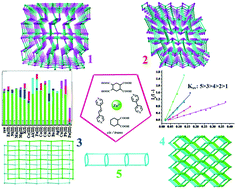Tunable photoluminescence in flexible carboxylate ligand-based coordination polymers with interesting topologies and Fe3+ sensitivity†
Abstract
Five new zinc coordination polymers based on flexible carboxylate ligands, namely, [Zn2(chtc)(H2O)]·3H2O (1), [Zn2(chtc)(4,4′-bpy)0.5] (2), [Zn(H2chtc)(bpe)] (3), [Zn(cis-chdc)(bpe)]·3H2O (4), and [Zn(trans-chdc)(bpe)(NO3)(H2O)]·H2O (5) (chtc/H2chtc = deprotonated/half-protonated cyclohexane-1e,2a,4a,5e-tetracarboxylic acid, cis/trans-chdc = cyclohexane-1e,2a/1e,2e-dicarboxylic acid, 4,4′-bpy = 4,4′-bipyridine, bpe = trans-1,2-(bis(4-pyridyl)ethene)) have been constructed and characterized. Owing to the tunability of linking ligands, these complexes show different interesting topological networks, namely uninodal umc three-dimensional network for 1, mtc three-dimensional non-manifold topology for 2, (4,4) net for the two-dimensional structure of 3, dmp-c interpenetrated network for 4, and one-dimensional ladder chain for 5. Notably, all complexes exhibit selectivity and sensitivity for Fe3+ ions with detection limit of less than 3.5 μM, which was correlated to the dimensionalities of the structures, implying their potential application in sewage detection.



 Please wait while we load your content...
Please wait while we load your content...